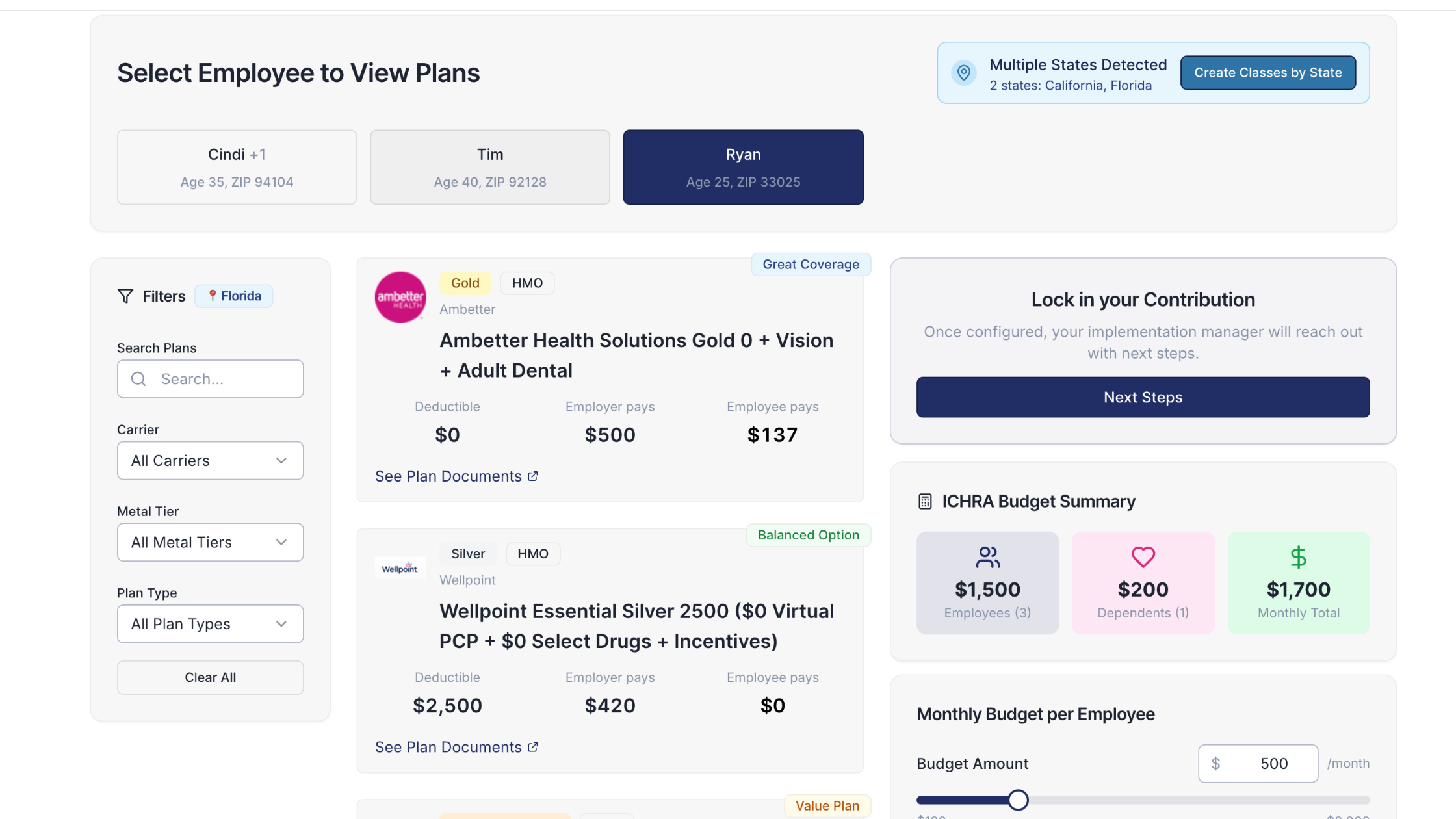Section 105 Plan vs. Section 125 Cafeteria Plan: Explained and Compared

This article sheds light on two common benefits plans: the Section 105 Plan and the Section 125 Cafeteria Plan.
What is a Section 105 Plan?
A Section 105 Plan, known as Medical Reimbursement Plans, allows businesses to reimburse their employees for qualified medical expenses, tax-free. These expenses can include everything from doctor visits and prescription medications to hospital stays and surgical procedures.
Types of Section 105 Plans
Health Reimbursement Arrangements (HRAs): Employers reimburse employees for out-of-pocket medical costs and, in some cases, individual health insurance premiums. Includes Qualified Small Employer HRA (QSEHRA), Individual Coverage HRA (ICHRA), and Group Coverage HRA (GCHRA).
Excepted Benefit HRA (EBHRA): Covers items not typically included in standard health insurance plans, such as dental and vision services.
Medical Expense Reimbursement Plans (MERPs): Covers patient and dependent medical expenses beyond traditional health coverage. It can be stand-alone or supplementary to group health insurance.
Accident and Health Plans: Provides additional protection for workplace accidents, ensuring employee health and safety are preserved.
What is a Section 125 Plan?
Now that we've covered all the ins and outs of Section 105 Plans, let's move on to their cousin, the Section 125 Cafeteria Plan. Don't worry, there's no actual food involved (although that would be nice).
Section 125 Plans offer a different set of advantages than Section 105 Plans. One of the main advantages is that they allow employees to pay for certain qualified expenses, such as healthcare, on a pre-tax basis. It's like having a magical money-saving wand.
By offering a Section 125 Plan, employers can help their employees stretch their hard-earned dollars further. And let's face it, who doesn't want to save money?
Types of Section 125 Plans
Premium Only Plan (POP): Allows employees to use pre-tax dollars to pay for their share of health insurance premiums.
Flexible Spending Account (FSA). Allows employees to set aside pre-tax dollars to pay for qualified expenses, such as medical bills or prescription drugs. It's like having a secret stash of cash just for healthcare expenses.
Dependent Care Assistance Plan (DCAP). This plan allows employees to use pre-tax dollars to pay for qualified dependent care expenses, such as daycare or after-school programs.
Health Savings Account (HSA). This type of Section 125 Plan allows employees to contribute pre-tax dollars to a savings account that can be used to pay for qualified medical expenses. It's like having a piggy bank specifically for healthcare costs.
Key Differences Between Section 105 and Section 125 Plans
Section 105 Plans allow employers to make contributions using pre-tax dollars toward their employees’ medical care. WhereawsSection 125 Plans take a different route by letting employees themselves pay for certain qualified expenses using pre-tax dollars. This distinction in contribution structure is crucial.
While Section 105 Plans are employer-centered in terms of contributions, Section 125 Plans shine with their employee-focused options. Employees can choose from a variety of pre-tax benefits, which adds flexibility and personalization to their financial planning.
Benefits of a Section 105 or a Section 125 Plan
Why should businesses care about Section 105 or 125 Plans? These plans offers businesses many advantages:
For the employer, the contributions made towards a Section 105 or Section 125 Plan are tax-deductible. This means that the business can reduce its taxable income, resulting in lower overall tax liability. Additionally, the employer does not have to pay payroll taxes on the reimbursements made to employees, further reducing the financial burden.
On the employee's side, the reimbursements received through the plan are not subject to federal income tax, social security tax, or Medicare tax. This translates into more take-home pay and increased disposable income for the employee. It's like getting a bonus without having to work extra hours!
But why are flexible medical benefits so crucial for employees today? The answer lies in the diverse landscape of healthcare needs. Employees prioritize benefits that can be adapted to their unique situations, whether it's managing chronic conditions, seeking alternative therapies, or covering family medical expenses. Flexibility ensures that employees feel supported and valued, which can lead to increased job satisfaction and retention.
These plans give employers the ability to design their own benefit packages. Imagine it as crafting a custom-made suit without the hefty price tag—perfectly fitting the specific needs of your team.
Every business is unique, and so are the healthcare needs of their employees. Businesses have the freedom to choose the types of medical expenses that will be covered, the reimbursement limits, and other plan details. This customization ensures that employees receive the benefits that matter most to them, whether it's coverage for prescription medications, dental care, or alternative therapies.
Ultimately, offering flexible medical benefits is not just a perk; it's a strategic move that aligns with modern employee expectations and enhances overall workplace morale.
How These Plans Compare to Traditional Group Health Insurance
With the rising costs of healthcare, many business are seeking alternatives to traditional group health insurance. Section 105 and Section 125 plans offer a way to provide comprehensive benefits while maximizing cost savings.
Both plans come with tax benefits and flexibility that traditional group health insurance might not offer. While group health insurance provides a blanket coverage approach, Section 105 and Section 125 plans allow for tailored benefits that can attract and retain key employees.
However, it's essential to understand the differences. Section 105 Plans focus on reimbursing employees for specific medical expenses, offering a customizable approach to healthcare benefits. In contrast, Section 125 Plans enable pre-tax contributions to cover various qualified expenses, providing a different form of financial relief.
By weighing these options, you can decide which plan aligns best with your business goals and employee needs. Whether it's the customizable nature of Section 105 or the pre-tax advantages of Section 125, each offers a unique way to tackle the challenge of rising health costs.
How Section 105 and Section 125 Plans Work
Establishing a Section 105 plan requires specific steps to ensure compliance and effective use. Here's a breakdown of how these plans operate:
- Plan Setup: Employers must create formal documents outlining the plan's details such as eligible expenses, plan duration, and any financial allowances available to employees. These documents ensure clarity and compliance.
- Contribution Guidelines: Some plans, like QSEHRAs, have annual contribution caps, while others, such as ICHRAs, do not impose these limits. Contributions from employers remain tax-deductible.
- Reimbursement Process: Employees make a claim by providing proof of expenses incurred. Employers review these claims and, if approved, provide tax-free reimbursements up to the designated allowance.
- Eligibility: Most Section 105 plans are available to all sizes of employers. Employees, including their spouses and dependents, can participate. Some plans, like ICHRA, allow customization of benefits based on employee classification (e.g., full-time, part-time).
- Owner Participation: Business owners' eligibility is contingent upon their tax filing status and organizational role. Generally, they can join the plan if classified as employees by the IRS.
- Administration: While employers can manage these plans independently, adhering to regulations such as ERISA, the Affordable Care Act, and HIPAA can be complex. Utilizing third-party administrators or specialized software is advisable to mitigate compliance risks.
Eligibility Requirements for Employers and Employees under a Section 105 Plan
When considering a Section 105 medical plan, it's crucial to understand the eligibility for both employers and employees. Here's a concise breakdown:
Employers:
- Applicable to All Sizes: Businesses of any size can implement a Section 105 plan.
- Business Type Consideration: The eligibility of business owners varies based on their organizational structure and tax filing status. To participate, the IRS must classify the business owner as an employee of their company.
Employees:
- Include All W-2 Employees: Anyone holding a W-2 status with the company, along with their spouses and dependents, can be part of the plan.
- Flexible Allowance Allocation: Employers have the flexibility to provide custom allowances to various employee classes. This includes full-time, part-time, seasonal, and temporary employees. This customization allows the benefits to be structured according to the needs and roles within the company.
Understanding these eligibility criteria will help ensure the Section 105 plan is effectively implemented, providing appropriate health benefits to the right individuals within your organization.
How to Set Up and Administer a Section 105 or 125 Plan
Setting up a Section 125 plan involves several essential steps for employers aiming to provide tax-advantaged benefits to their employees. Here's a detailed breakdown of the process and compliance regulations involved:
Establishing the Plan
- Create Formal Plan Documents: Employers need to draft comprehensive plan documents, outlining the specifics of the Section 125 plan. This often involves consulting with professionals like attorneys, tax consultants, brokers, or third-party administrators (TPAs) to ensure all legal requirements are met.
- Inform Employees: Once the plan is ready, it's crucial to communicate the benefits to your workforce. Employers should establish a clear and accessible process for employees to understand how to enroll and what options are available.
- Benefit Administration: Handling the ongoing administration is key. Many organizations use third-party administrators or specialized benefits administration software to manage the details and logistics of the plan effectively.
Compliance and Regulations
- Nondiscrimination Testing: Compliance with IRS regulations requires running three annual nondiscrimination tests. These tests ensure the plan does not favor highly compensated employees, officers, or business owners over the broader employee base. It's crucial to maintain detailed records of these test results.
By following these steps and adhering to compliance requirements, employers can successfully implement a Section 125 plan, offering valuable benefits while enjoying the tax advantages these plans provide.
Eligibility Requirements for Employers and Employees under a Section 105 or 125 Plan
When considering a Section 105 medical plan, it's crucial to understand the eligibility for both employers and employees. Here's a concise breakdown:
Employers:
- Applicable to All Sizes: Businesses of any size can implement a Section 105 plan.
- Business Type Consideration: The eligibility of business owners varies based on their organizational structure and tax filing status. To participate, the IRS must classify the business owner as an employee of their company.
Employees:
- Include All W-2 Employees: Anyone holding a W-2 status with the company, along with their spouses and dependents, can be part of the plan.
- Flexible Allowance Allocation: Employers have the flexibility to provide custom allowances to various employee classes. This includes full-time, part-time, seasonal, and temporary employees. This customization allows the benefits to be structured according to the needs and roles within the company.
Understanding these eligibility criteria will help ensure the Section 105 plan is effectively implemented, providing appropriate health benefits to the right individuals within your organization.
Summary: The Benefits of Section 105 and Section 125 Plans
By providing employees with the opportunity to participate in a Section 105 or Section 125 Plan, employers can demonstrate their commitment to their employees' well-being and financial security.
But it doesn't stop there. The benefits of these plans extend beyond just tax savings and employee satisfaction. By implementing a Section 105 or Section 125 Plan, employers can also enjoy cost savings. With rising healthcare costs, finding ways to manage expenses is crucial for businesses of all sizes. These plans can help employers control their healthcare spending while still providing valuable benefits to their employees.
The path to employee benefits greatness may be paved with acronyms, but with the right knowledge, you can navigate it with ease.
You got questions, we got answers!
We're here to help you make informed decisions on health insurance for you and your family. Check out our FAQs or contact us if you have any additional questions.
Explore more related content
What is Venteur
Explore the best human-first Health Insurance platform
Simple, personalized health benefits
Sign up in minutes, define your contribution, and let your employees choose the health plan that works right for them
Integrations to make everything run smoothly
We'll connect with your payroll and finance systems to make deductions and premium payments seamless
Easy onboarding and off-boarding
In just a few clicks, add your roster and make updates on the fly. We'll handle it from there.
Venteur Certified Brokers to help your employees pick the right plan
Our trusted brokers ensure the best outcomes for employees and employers by unlocking health savings and providing unrivaled plan options.
AI-powered plan recommendations to give you confidence while you shop
Backed by 30 years of healthcare data, Venteur’s AI helps employees compare and choose the best plan for their unique situation.
Compliance and reporting because no-duh!
Venteur manages plan administration, reporting, and compliance so you can focus on growing your business.


